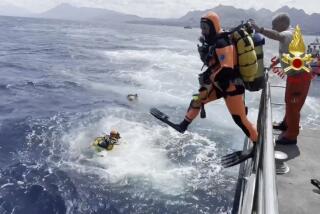Wind Whips Yacht Race Into a Struggle for Life
- Share via
One of the most massive sea rescue operations in Australian history continued today in the aftermath of an ocean yacht-racing disaster that officially claimed five lives and may take dozens more.
Tales of trauma, terror and death reached the mainland in southeastern Australia as hundreds of bruised and battered survivors of a devastating South Pacific storm that started Sunday night came ashore.
More than half of the 115 boats that began the 725-mile race from the mainland to southern Tasmania either were abandoned or forced to seek shelter. Race officials estimated that approximately 1,000 sailors began the race.
“It doesn’t get much worse than this,” said Mike Howard of Los Angeles, reached by telephone just hours after arriving at the end of the 54-year-old Sydney-to-Hobart race. He was a crew member of the winning yacht Sayonara, a 79-foot maxi boat that had sufficient size to survive winds that reached 90 mph and swells as high as 35 feet.
Howard underscored the danger of the situation when he said, “My philosophy is, if you fall off the boat, you die.”
The owner of the San Francisco-based Sayonara, billionaire Larry Ellison, founder and CEO of computer giant Oracle, was shaken to tears. “It was just awful,” he told Associated Press. “I’ve never experienced anything remotely like this.” Asked if he’d come back again, Ellison said, “My first reaction is, not if I lived to a thousand years. But who knows?”
Also aboard Sayonara was Lachlan Murdoch, son of Rupert Murdoch, media magnate and Los Angeles Dodger owner. Lachlan Murdoch is chief executive of News Limited Corp.
Howard told The Times that casualty figures being unofficially disseminated among the arriving crews had eight dead and 16 more lost at sea.
But Australian officials, reached later by The Times, strongly denied that the numbers were that high.
“The absolute, as of this moment [midafternoon today in Australia] are five dead and one missing,” said David Gray, manager of public relations for the Australian Maritime Safety Authority, which had as many as 27 sea rescue vessels and 30 aircraft involved in the effort in the Bass Strait, one of the world’s most notoriously dangerous sailing stretches, about 250 miles south of Sydney. Because of the Bass Strait, this race is frequently referred to by veteran sailors as “Hell on Highwater.”
At least 40 sailors were plucked from the water during Monday’s rescue.
As of midday today, two of the dead sailors, on the 40-foot Australian boat Business Post Naiad, remained harnessed to the deck of their boat, adrift at sea but observed by rescue craft. One apparently died of a heart attack when the boat rolled over--a full 360 degrees--twice, while the other drowned during the rollovers when he was unable to release his safety harness.
The other three official deaths were from the yacht Winston Churchill. Six members were rescued from life rafts, but three others were washed out to sea and presumed dead.
The official death tally remained elusive. One report had a sixth death confirmed--British Olympic sailor Glyn Charles, who was washed off his boat Sunday night and presumed dead. He finished 11th in the Star Class at the Atlanta Olympics in 1996.
Gray said the possibilities of more deaths could not be discounted.
He said that about 40 boats sought shelter in the small port town of Eden, and that most arrived with broken masts and rigging. Upon arrival, many sailors were taken directly from boats by ambulance to hospitals, most suffering broken bones, dislocations and severe cuts.
“There were just many, many injuries on those boats that were knocked down [blown flat on their side],” he said. “A lot of them rolled over, one twice. They really got pounded.”
One report called the rescue area a “scene of orange life rafts heaved in roiling seas.” Another called it “towering seas that turned 40-foot yachts into tub toys, flipping them over, snapping their masts and swamping them with water.”
Howard said the Sayonara, with its 23 crew members, had been fortunate to be so large and fast that it may have stayed in front of the worst parts of the storm. But that didn’t mean his trip was easy.
“I was concerned for the boat, with the pounding we took for a good 48 hours of the race,” he said. “Sometimes, it was just survival conditions. Numerous times, you thought the boat was just going to split in two.”
The worst disaster in yacht-racing history was the 1979 Fastnet race, where 15 sailors perished off the southwest coast of Ireland. In that race, 303 boats started, and only 85 finished, including the winning boat skippered by television magnate Ted Turner.
Howard said that lessons learned from the Fastnet experience, and long discussed among sailors, still weren’t heeded in the Sydney-to-Hobart disaster--specifically, that it is safer to remain with the yacht than to abandon it for rubber rafts.
“As soon as you inflate the raft, the wind is trying to blow it away from the boat,” he said. “You [need to] inflate it at the back of the boat, and it’s the last thing you get into.”
More to Read
Sign up for Essential California
The most important California stories and recommendations in your inbox every morning.
You may occasionally receive promotional content from the Los Angeles Times.












